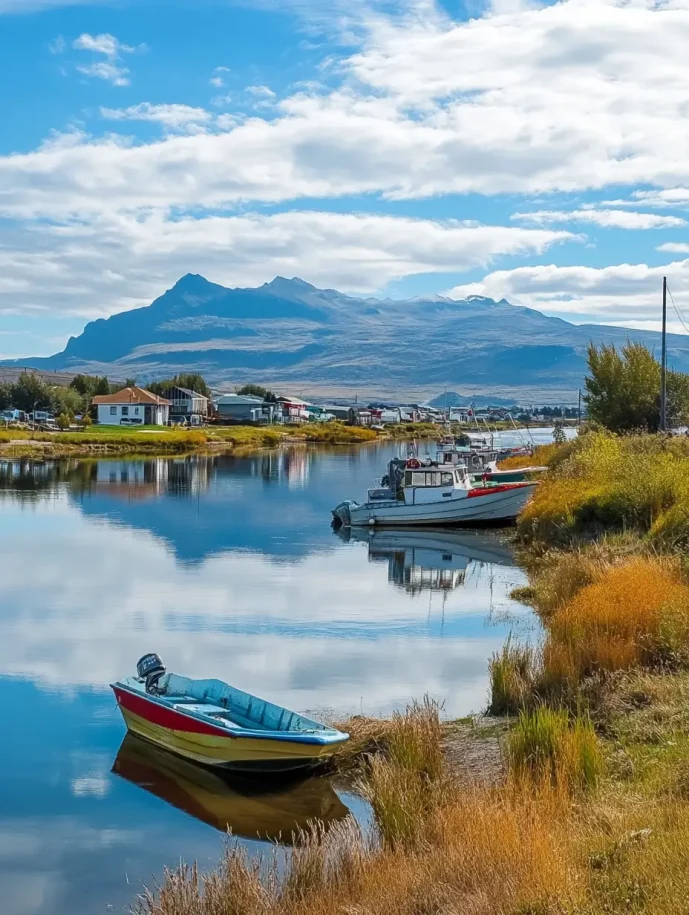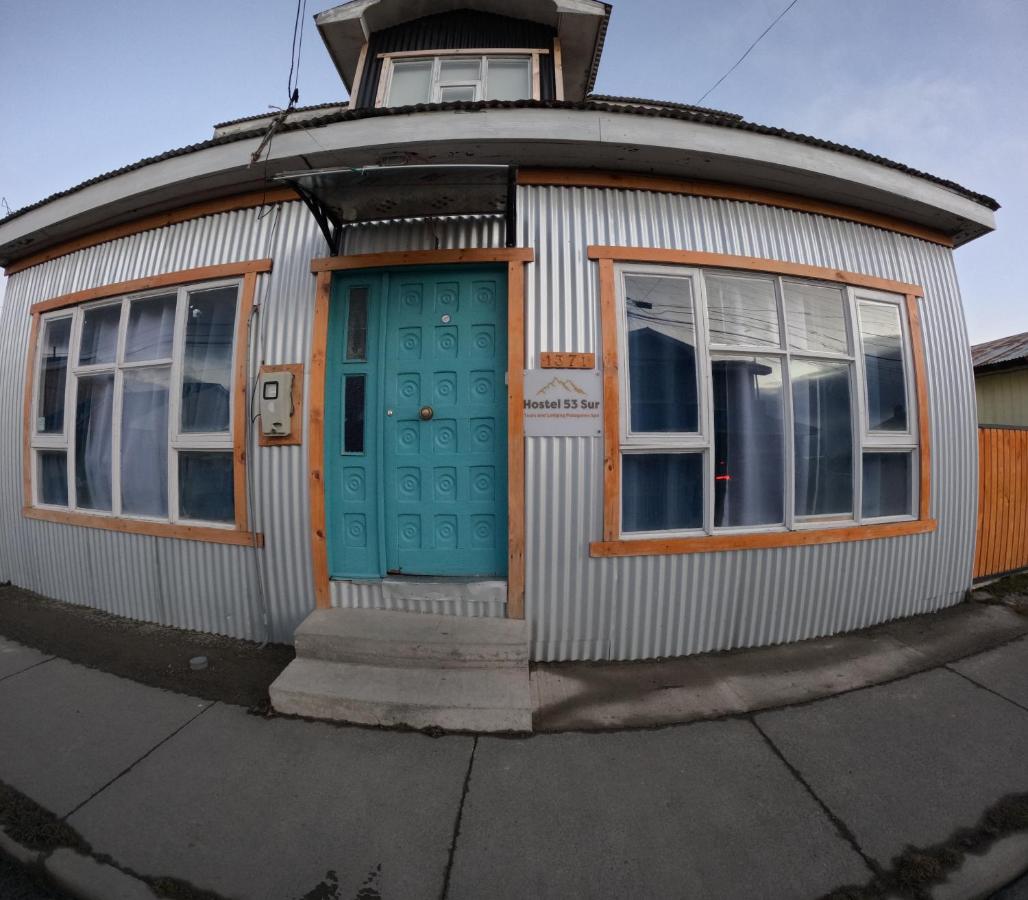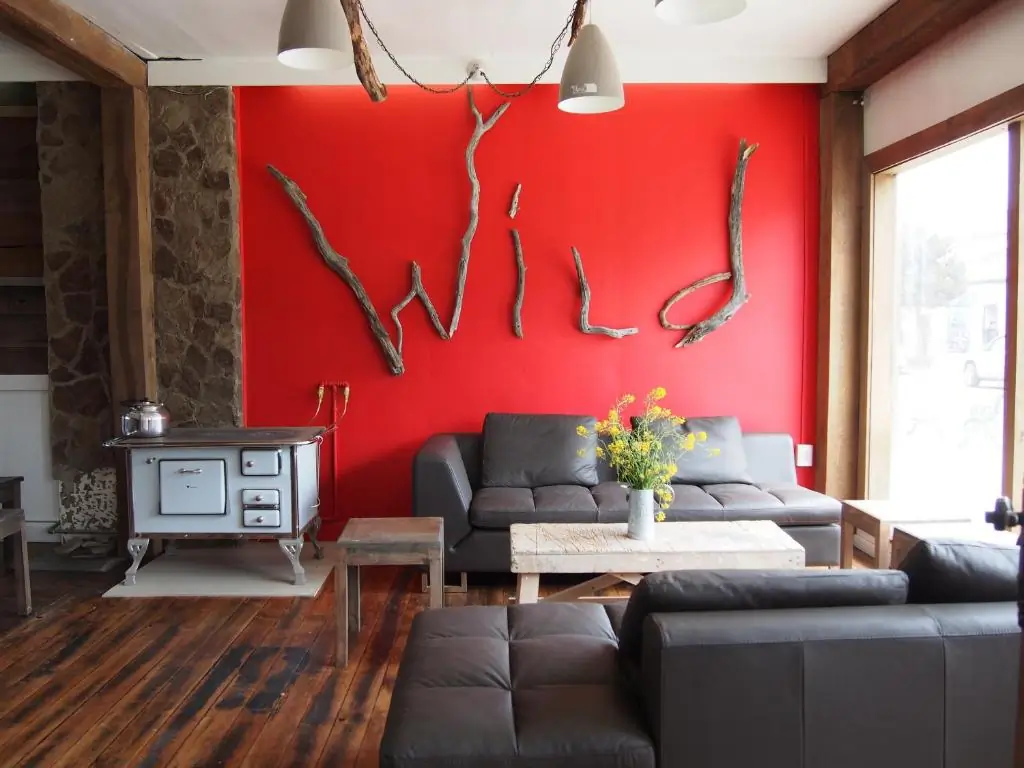Puerto Natales
A gateway to Patagonia's wonders, Puerto Natales offers dramatic landscapes like O'Higgins Glacier, Cerro Paine Grande, and the mesmerizing Ice Caves of Glaciar Grey, blending adventure with raw natural beauty.

Nestled in the windswept wilds of far southern Chile, Puerto Natales is a ruggedly charming gateway to Patagonia’s untamed beauty. With its colorful clapboard houses and waterfront promenade, this quiet fishing town hums with frontier spirit, offering respite before adventures into Torres del Paine. Here, the air is crisp, the landscapes vast, and the sense of remoteness intoxicating.
Destination Facts
- Official Name: Puerto Natales
- Type of Destination: Town
- Brief Description: A charming gateway to Patagonia, Puerto Natales is a rugged yet inviting town known for its colorful houses, dramatic fjords, and proximity to Torres del Paine National Park.
- Location: Situated on the shores of the Última Esperanza Sound in the Magallanes and Chilean Antarctica Region, far southern Chile.
- Year Established/Founded: 1911
- Governing Body/Management: Municipalidad de Natales (Natales Municipality)
- Significance/Known For: Primary access point for Torres del Paine National Park and a hub for Patagonian adventure tourism.
- Population: Approximately 20,000 (as of recent estimates)
- Main Attractions/Key Features:
- Torres del Paine National Park (UNESCO Biosphere Reserve)
- Mylodon Cave (Cueva del Milodón), a prehistoric site
- Scenic waterfront promenade with views of the Andes
- Best Time to Visit: October to April (Patagonian summer) for milder weather, though winter offers solitude and stark beauty.
- Entrance Fee/Ticket Info: N/A (Town itself has no entrance fee; attractions like Torres del Paine require separate permits.)
- Operating Hours: N/A (Town is accessible year-round; specific attractions vary.)
- Website: muninatales.cl (Municipality's official site)
Essentials
- Top Attractions: O’Higgins Glacier, Cerro Paine Grande, Dientes de Navarino circuit, Ice Caves in Glaciar Grey (Torres Del Paine)
- Best Months to Visit: December, February, January, November
- Best Hotels: Hostal 53 Sur, Weskar Lodge, Hostel 53 Sur, Hostal B&B Coastal Natales, Wild Hostel
Tours and Day Trips
Torres del Paine National Park
No visit to Puerto Natales is complete without a journey to Torres del Paine National Park, a UNESCO Biosphere Reserve renowned for its jagged peaks, glacial lakes, and sweeping Patagonian steppe. Day trips typically include hikes to viewpoints like Mirador Las Torres or leisurely drives past landmarks such as Grey Glacier and Lake Pehoé. The park is ideal for adventure seekers and nature lovers, with excursions ranging from 8 to 12 hours. Wildlife sightings—guanacos, condors, and perhaps even pumas—add to the allure.
Balcony of the Andes: Sierra Baguales
For those seeking a lesser-known gem, the Sierra Baguales offers a rugged, off-the-beaten-path experience. This high-altitude plateau, a 1.5-hour drive from Puerto Natales, is often called the “Balcony of the Andes” for its panoramic views of the Paine Massif and vast fossil beds. Guided hikes or 4×4 tours reveal Patagonia’s geological history, with stops at wind-sculpted rock formations. Suitable for intrepid travelers and geology enthusiasts, the excursion lasts around 6 hours.
Boat Excursion to Serrano Glacier
A serene yet dramatic day trip involves a boat journey from Puerto Natales to the Serrano Glacier, nestled within Bernardo O’Higgins National Park. Travelers glide past fjords and waterfalls before disembarking for a short hike to the glacier’s face. Some tours include a stop at a traditional estancia for lamb barbecues, blending natural beauty with local culture. The 10-hour round trip appeals to photographers and those favoring a slower pace.
Milodón Cave & Local History
History and myth intertwine at the Milodón Cave, a short 30-minute drive from town. This vast cavern is famed for the discovery of prehistoric remains, including those of a giant ground sloth. Interpretive trails and life-sized replicas make it accessible for families, while the surrounding forested hills invite light hiking. The visit, often paired with stops at Puerto Natales’ waterfront or artisan markets, fills a half-day.
Kayaking the Río Serrano
Active travelers may opt for a kayak descent down the Río Serrano, which winds through Torres del Paine’s foothills. Paddlers encounter rapids, quiet stretches flanked by ñirre forests, and distant views of the Paine Massif. Tours, led by expert guides, cater to beginners and experienced kayakers alike, lasting 6–8 hours with picnic lunches along the riverbanks.
Accommodation
Weskar Lodge
Nestled in a serene natural setting, Weskar Lodge offers cozy accommodations with breathtaking views, perfect for travelers seeking tranquility and a connection with nature.
Hostel 53 Sur
Nestled in the heart of Puerto Natales, Hostel 53 Sur offers cozy accommodations with stunning views, perfect for adventurers exploring the breathtaking landscapes of Chilean Patagonia.

Hostal B&B Coastal Natales
A charming, cozy retreat in Puerto Natales, Hostal B&B Coastal Natales offers breathtaking views and warm hospitality, perfect for exploring the stunning Patagonian landscapes of Chile.
Wild Hostel
Wild Hostel, nestled in the heart of Puerto Natales, offers cozy accommodations with rustic charm, making it an ideal base for Patagonian adventures and local explorations.

Hotel Baquedano (Puerto Natales)
Hostal La Base
Hostal La Base offers cozy accommodations in Puerto Natales, Chile, providing a welcoming atmosphere with comfortable rooms, perfect for resting after exploring the stunning Patagonian landscapes.
Cabañas Última Esperanza
Nestled in the breathtaking landscapes of Puerto Natales, Cabañas Última Esperanza offers cozy accommodations, perfect for exploring Chile's pristine Patagonian wilderness. Ideal for nature lovers and adventurers alike.
Trotamundos
Trotamundos in Puerto Natales offers cozy charm and delicious local cuisine, providing travelers with a warm and inviting atmosphere in the heart of Chilean Patagonia.
Hotel Altiplanico Puerto Natales
A charming retreat in Puerto Natales, Hotel Altiplanico offers stunning views of the Patagonian landscape, blending rustic elegance with modern comfort—an ideal base for exploring Torres del Paine National Park.
When to visit
Best Time to Visit Puerto Natales
Puerto Natales, a charming gateway to Patagonia, experiences a subpolar oceanic climate with strong winds, cool temperatures, and unpredictable weather year-round. The best time to visit depends on your tolerance for cold, preference for outdoor activities, and desire to avoid crowds.
Seasonal Breakdown
Summer (December–February)
The warmest months, with temperatures ranging from 8°C to 18°C (46°F to 64°F), offer long daylight hours—up to 17 hours in December. Rainfall is moderate, but winds can be fierce.
- Pros: Ideal for trekking in Torres del Paine, kayaking, and wildlife spotting (guanacos, condors). Most trails and tours operate.
- Cons: Peak tourist season; higher prices for accommodations and flights. Limited availability for last-minute bookings.
- Events: Fiesta de la Virgen de Monserrat (February) features local traditions and rodeos.
Autumn (March–May)
Temperatures drop to 3°C–12°C (37°F–54°F), and autumn foliage paints the landscapes in gold and red. Rainfall increases slightly, but crowds thin by April.
- Pros: Fewer visitors, lower prices, and stunning photography conditions. Still suitable for hiking with proper gear.
- Cons: Shorter days; some tour operators reduce schedules.
- Events: Patagonian Expedition Race (March) attracts adventure athletes.
Winter (June–August)
Cold and harsh, with temperatures between -2°C and 6°C (28°F–43°F). Snowfall is common, and daylight dwindles to 8 hours.
- Pros: Solitude and dramatic snowy landscapes. Unique winter trekking and photography opportunities.
- Cons: Many lodges and tours close; roads may be impassable. Limited services in Torres del Paine.
- Events: Winter Solstice celebrations in June highlight local culture.
Spring (September–November)
Temperatures rise to 4°C–14°C (39°F–57°F), and wildflowers bloom. Winds remain strong, but daylight increases.
- Pros: Renewed wildlife activity (flamingos, foxes). Shoulder-season prices and fewer crowds.
- Cons: Unpredictable weather—sudden snowstorms or rain showers.
- Events: Patagonian International Marathon (September) draws runners to scenic routes.
Overall Recommendation
For outdoor enthusiasts: December–February offers the most reliable conditions for trekking and wildlife. For solitude and photography: March–April or September–November provide quieter trails and vibrant landscapes. Winter travelers should prepare for limited services but unparalleled serenity.
Considerations
Peak season (December–February) demands advance bookings, while shoulder seasons (autumn and spring) balance affordability and accessibility. Winter visits require self-sufficiency and flexibility due to weather disruptions.
What to pack
What to Pack for Puerto Natales
Puerto Natales, a windswept gateway to Patagonia, demands practical preparation for its unpredictable weather and rugged terrain. Here are the essentials to ensure comfort and adaptability.
Clothing & Protection
- Windproof & Waterproof Jacket: The Patagonian wind is relentless; a high-quality shell is non-negotiable.
- Layered Clothing (Merino Wool or Fleece): Temperatures shift rapidly—thermal base layers and mid-layers provide flexibility.
- Sturdy Hiking Boots: Essential for exploring Torres del Paine or uneven town streets, preferably waterproof.
- Warm Hat & Gloves: Even in summer, chilly gusts necessitate protection for extremities.
Gear & Accessories
- Daypack with Rain Cover: Sudden showers are common; keep essentials dry during excursions.
- Reusable Water Bottle: Refill stations are available, and tap water is safe to drink.
- UV-Blocking Sunglasses: The southern light is intense, and wind can irritate eyes.
- Quick-Dry Towel: Useful for impromptu boat trips or hostel stays.
Miscellaneous
- Cash (Chilean Pesos): Smaller establishments may not accept cards, and ATMs can be scarce.
- Portable Power Bank: Cold drains batteries quickly; backup power is wise for long hikes.
- Spanish Phrasebook: While tourist areas accommodate English, basic phrases smooth interactions.
Culture
A Frontier Town with Patagonian Soul
Puerto Natales, perched on the shores of the Seno Última Esperanza, is a place where the ruggedness of Patagonia meets the quiet resilience of its people. Unlike the more cosmopolitan Punta Arenas, this town retains the air of a frontier outpost, shaped by its history as a hub for sheep farming and maritime trade. The culture here is deeply intertwined with the land and sea, where the wind carries stories of gauchos, explorers, and the indigenous Kawésqar people.
Local Identity & Social Customs
Life in Puerto Natales moves at the pace of the weather—unpredictable yet deliberate. The town’s social fabric is woven with a strong sense of community, where neighbors greet each other on the street and shopkeepers remember your name after a single visit. Visitors will notice a distinct lack of pretense; warmth is offered freely, but respect for the harsh environment is non-negotiable.
- Mate culture: Sharing mate (herbal tea) is a ritual here, often accompanied by long conversations about the day’s adventures or the latest storm.
- Gaucho influence: The legacy of Patagonian cowboys is evident in the local dress—wool ponchos and sturdy boots—and in the pride taken in horsemanship.
Cuisine: A Taste of the Wild
Puerto Natales’ cuisine is a testament to survival in a harsh climate. The town’s isolation has fostered a culinary tradition reliant on local ingredients, prepared simply but with care.
Must-Try Dishes
- Cordero al Palo: Spit-roasted lamb, a Patagonian staple, often cooked over an open fire for hours.
- Centolla: The prized king crab, best enjoyed in season (May–August), served with a squeeze of lemon.
- Calafate Sour: A twist on the pisco sour, using the tart calafate berry, said to ensure your return to Patagonia.
Arts & Craftsmanship
The town’s artistic expressions are as raw and unfiltered as the landscape. Local artisans work with wool, leather, and wood, creating pieces that reflect Patagonia’s textures and tones.
- Wool weaving: Look for hand-knitted guantes (gloves) and calcetines (socks) dyed with natural pigments.
- Driftwood sculptures: Artists like Francisco Gazitúa have elevated found materials into striking public art.
Festivals & Seasonal Rhythms
Puerto Natales celebrates its Patagonian identity with events that blend tradition and modernity.
- Fiesta de la Nieve (July): A winter festival featuring dog sledding, folk music, and communal asados (barbecues).
- Día de la Patagonia (October): A celebration of regional heritage with gaucho demonstrations and storytelling.
Historical Echoes
The town’s culture is deeply marked by its past. The Museo Histórico Municipal offers glimpses into the lives of early settlers, while abandoned estancias (ranches) dotting the countryside speak to the boom-and-bust cycles of wool production. The influence of European immigrants—particularly Croats and Germans—is still felt in family names and architectural details.
History
History of Puerto Natales
Nestled on the shores of the Seno Última Esperanza (Last Hope Sound), Puerto Natales is a town born from the rugged frontier spirit of Patagonia. Founded in 1911 as a port for the sheep farming industry, its history is intertwined with the exploitation of the region’s vast grasslands and the slow, often harsh, integration of southern Chile into the modern world. The town’s name, meaning “Port of the Natales,” reflects its early role as a gateway for settlers and goods. Over time, Puerto Natales evolved from a remote outpost into a vital hub for explorers and travelers venturing into Torres del Paine and the surrounding wilderness.
The indigenous Kawésqar people once navigated these fjords, but European colonization in the late 19th and early 20th centuries dramatically reshaped the region. The arrival of German, British, and Croatian immigrants left a lasting cultural imprint, visible in the town’s architecture and traditions. Today, Puerto Natales balances its pastoral roots with its modern identity as the gateway to Patagonia’s natural wonders.
Key Historical Dates
- 1911: Official founding of Puerto Natales as a port for the Sociedad Explotadora de Tierra del Fuego, a major sheep farming enterprise.
- 1920s-1930s: Immigration waves, particularly from Europe, shape the town’s cultural and economic landscape.
- 1970s: The creation of Torres del Paine National Park marks the beginning of Puerto Natales’ transformation into a tourism hub.
- 1980s-1990s: Decline of the sheep farming industry leads to a shift toward adventure tourism and conservation.